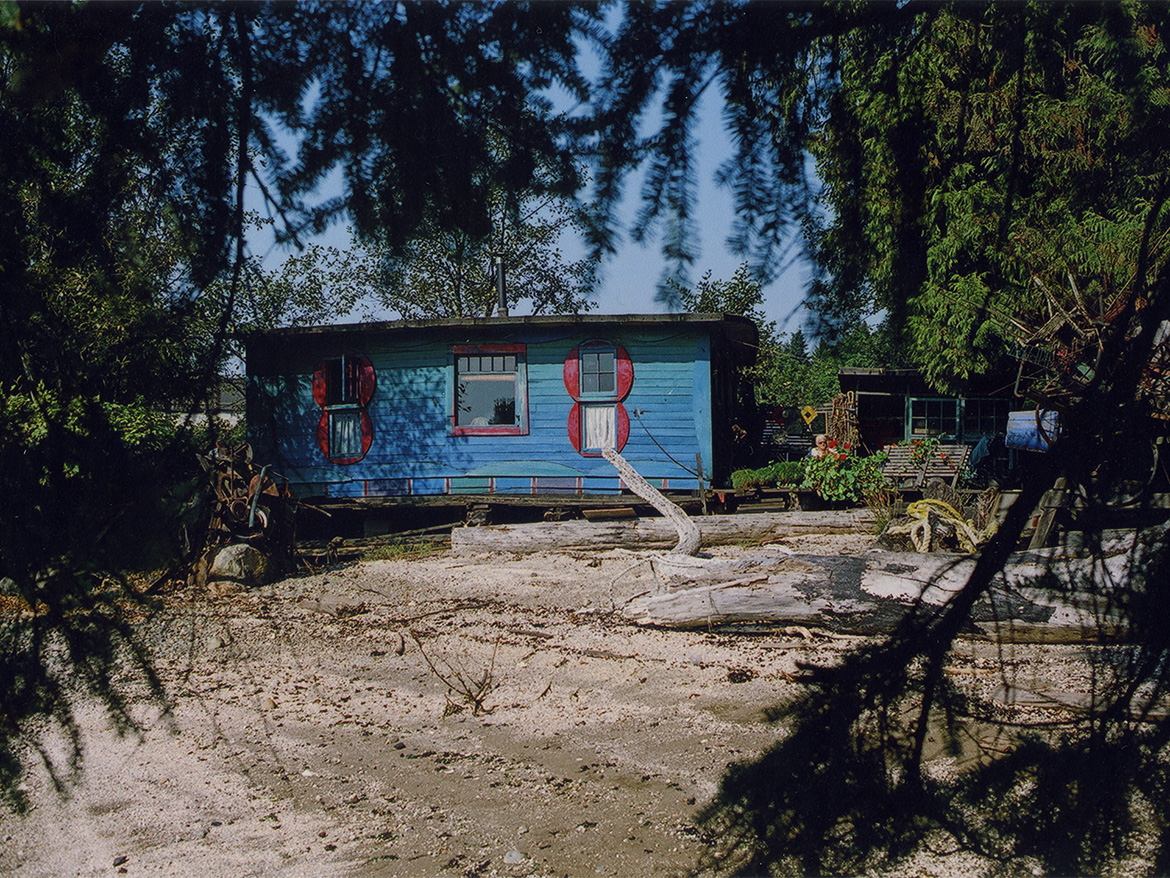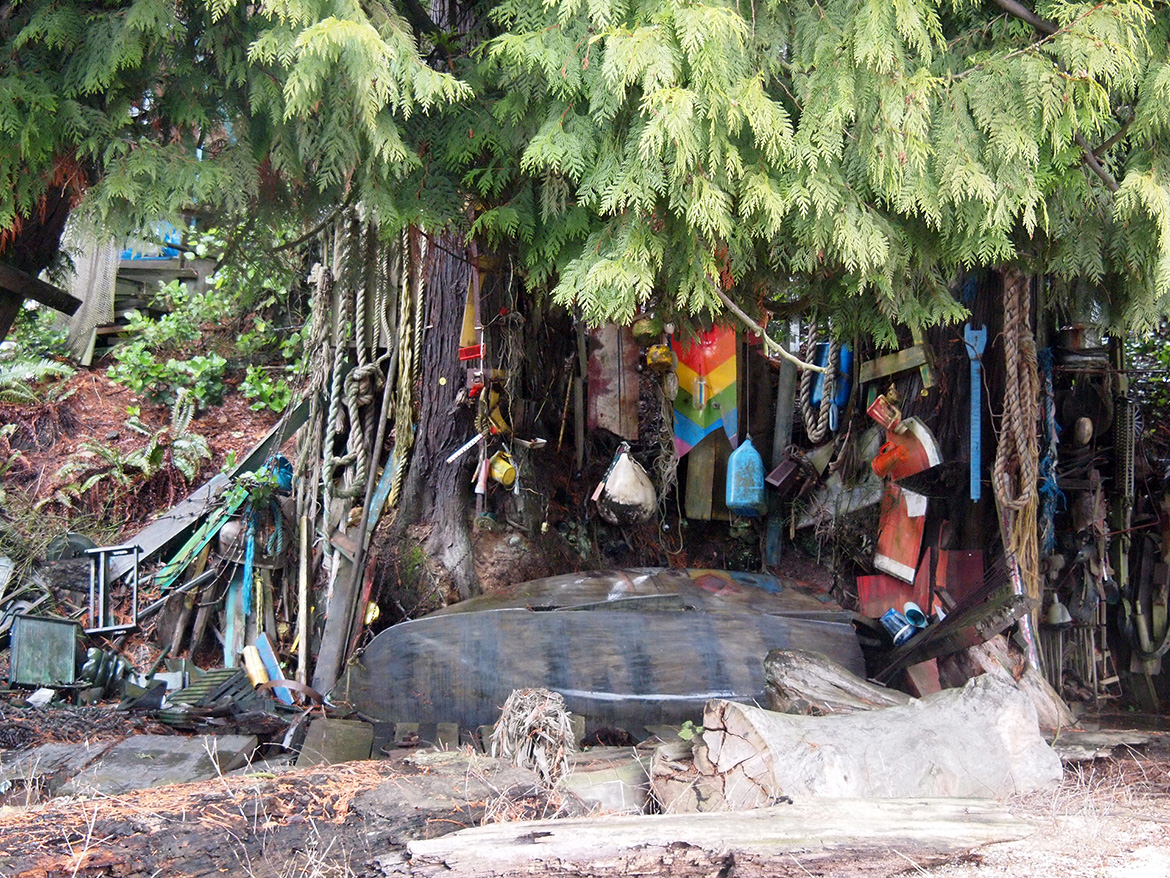The Blue Cabin History
The Blue Cabin is a dwelling that has resisted ownership for 80 years or more. Built circa 1927 in Coal Harbour, Vancouver, by a Scandinavian craftsman, the cabin was towed to the western boundary of Cates Park in 1932 when its builder took a job with McKenzie Barge & Derrick Co., Ltd. (later McKenzie Barge and Marine Ways Ltd.). There, he set the cabin on pilings above the high and low tides on Tsleil-Waututh (səlilwətaɬ) territory within the District of North Vancouver,1 adjacent to the McKenzie Barge site, and lived in it while he worked there.2

Photo: Carole Itter, Dollarton Cabin, 2015
Further up the Inlet toward Cates Park sat two squatter shacks previously occupied by McKenzie Barge workers. These humble dwellings had escaped the general razing of shacks in the 1950s,3 but by the 1970s the two structures were occupied by squatters and beachcombers, who were soon evicted and the shacks destroyed. The Blue Cabin remained intact, as it was the only dwelling with a direct connection to McKenzie Barge due to its proximity to their site.4
Musician, artist and writer, the late Al Neil5 inhabited the cabin from 1966 when he first rented it from McKenzie Barge. His partner, artist, writer and filmmaker Carole Itter, joined Al at the cabin about twelve years later, and both used this special site as a generative place for art production until their eviction in 2015.6
Little is known about how long the original builder remained at the cabin, or who might have lived there after his departure and before Neil moved in. Itter doesn’t recall any mention of tenants before Neil’s time, and the cabin had been empty for a number of years before he moved in. Neil did recall being told that for a short time prior to his tenancy, the cabin served as a lunchroom for McKenzie Barge employees.7
Neil moved to the cabin after hearing about it from a friend. Itter writes, “He and his then wife’s little house in the West End burned down, and they were looking everywhere for a place outside of the city. He was given a tip about the cabin being available. Al had wanted to get out of the city for personal reasons, as he was having trouble with his health. So, Al did forty-eight years there and I joined him for the last thirty-five of those years.”8
McKenzie Barge set Neil’s rent at $15 per month. They provided electrical power to the cabin by running extensions from the McKenzie Barge site. Later into his tenancy, Neil assumed the role of unofficial beach watchman in exchange for free rent. McKenzie Barge was keen to have him on the property, as the cabin was the only structure between the beach and the McKenzie site.

Assemblage, Al Neil and Carole Itter. Photo: Esther Rausenberg 2015

Assemblage, Al Neil and Carole Itter. Photo: Esther Rausenberg 2015
In November 2014, after the land adjacent to the cabin had been purchased by Polygon Homes with an intention to develop the site, Port Metro served Neil and Itter with an eviction notice and ordered the cabin removed by the end of January 2015. As part of their development plan, Polygon agreed to remediate the neighbouring contaminated foreshores, which included the small cove where the cabin was situated, so it had to be moved.9
Neil and Itter took on the profound task of packing up and moving back to the city after decades on the Dollarton foreshore. Neil was approaching ninety-one and had lived at the cabin for more than half of his life. Itter had maintained her Strathcona residence throughout her years at the Blue Cabin and had always moved between the Dollarton shore and her home in the city. Neil had also stayed there from time to time, especially during the winter months. It was there that they settled after leaving the cabin.
In late June 2015, the cabin was prepped for removal from the cove on the Dollarton foreshore. Polygon Homes replaced the narrow road to the highway with a more substantial one, as it had been damaged during the demolition of the shipyard.10 They also generously paid for the move. On June 23, 2015, the cabin was trucked along Dollarton Highway to a protected, temporary storage lot at Canexus Corporation,11 a few miles up the road.12 It remained there for close to two years before it was transferred to its remediation site.
The cabin’s forced removal and the subsequent development of Cates Landing is representative of the ongoing gentrification of the Burrard Inlet foreshore. As the last remaining squatter dwelling along the Burrard Inlet foreshore,13 the Blue Cabin represents a very special time in Vancouver’s history. It has been described as the unique survivor of a once popular, but now vanished way of life, when people of little means could live ‘off the grid’ in ‘squats’ along the waterfront, yet still be near to an urban centre.14
The condominium development Cates Landing now overlooks the waterfront where the cabin once sat.
Continue learning about the Blue Cabin in this short historical video:
- Cole Projects, ‘Blue Cabin Floating Artist Residency Preliminary Feasibility Report’, Page 5, August 2016.
- Harold Kalman & Andrew Todd Conservators Limited, ‘A Plan for the Conservation and Re-use of the Blue Cabin’, Page 6, December 2015. Kalman writes that the land adjacent to the cabin came to be used for shipbuilding and other marine industries, principally by McKenzie Barge and the Dollarton Shipyard.
- Nancy Kirkpatrick, ‘Historical Background: Al Neil and Carole Itter’s Foreshore Cabin’, Document 2650397, Page 2, December 2014.
- Carole Itter in conversation with Marlene Madison, Blue Cabin’s former Development Director, May 2019.
- Learn more about Al Neil at http://alneil.vancouverartinthesixties.com/
- Cole Projects, ‘Blue Cabin Floating Artist Residency Preliminary Feasibility Report’, Page 5, August 2016.
- Carole Itter’s email to Marlene Madison, Blue Cabin’s Development Director, August 2018.
- Ibid.
- Cole Projects, ‘Blue Cabin Floating Artist Residency Preliminary Feasibility Report’, Page 5, August 2016.
- Carole Itter in conversation with Marlene Madison, Blue Cabin’s former Development Director, May 2019.
- Canexus Corporation was acquired by Chemtrade Logistics in March 2017, and now operates as Chemtrade Electrochem Inc.
- See video of all the cabin’s moves on The Blue Cabin Vimeo page.
- Harold Kalman & Andrew Todd Conservators Limited, ‘A Plan for the Conservation and Re-use of the Blue Cabin’, Pages 18, 19, December 2015.
- Nancy Kirkpatrick, ‘Historical Background: Al Neil and Carole Itter’s Foreshore Cabin’, Document 2650397, Page 7, December 2014. Harold Kalman & Andrew Todd Conservators Limited, ‘Conservation & Re-use Plan for the Blue Cabin’, Pages 6, 67, December 2015.